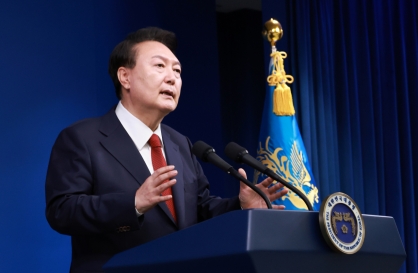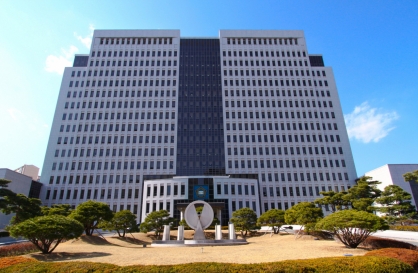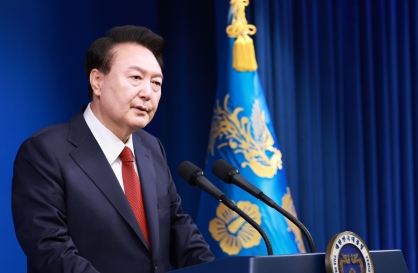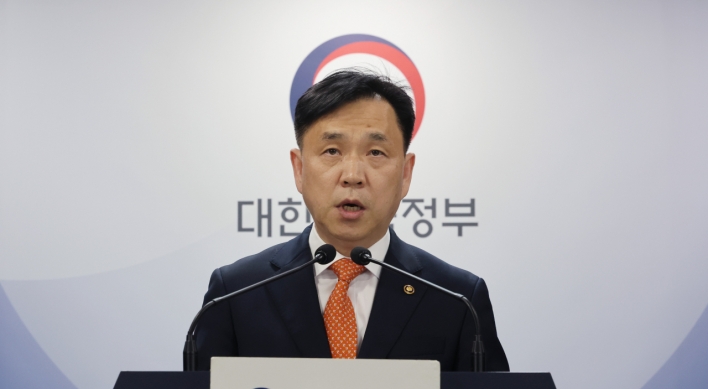Energy poverty, environmental sustainability rising as tough challenges
Korea urged to reduce dependency on imported oil through improved energy efficiency and use of renewables
By Seo Jee-yeonPublished : Oct. 13, 2013 - 19:34
The global energy industry is fast changing with the shale gas revolution in North America and sharp increase in energy demand, particularly in Asia.
But a top IEA official stresses that two major long-term challenges facing the world are energy poverty and environmental sustainability.
In a written interview with The Korea Herald ahead of the opening of the 2013 World Energy Congress in Daegu, International Energy Agency executive director Maria van der Hoeven also advised natural resource-deficient Korea to diversify its import sources of crude oil and refined products, and enhance efforts to reduce dependency on imported oil through improved energy efficiency and increased use of renewables.
Following is an excerpt from the interview with IEA executive director Van der Hoeven.
But a top IEA official stresses that two major long-term challenges facing the world are energy poverty and environmental sustainability.
In a written interview with The Korea Herald ahead of the opening of the 2013 World Energy Congress in Daegu, International Energy Agency executive director Maria van der Hoeven also advised natural resource-deficient Korea to diversify its import sources of crude oil and refined products, and enhance efforts to reduce dependency on imported oil through improved energy efficiency and increased use of renewables.
Following is an excerpt from the interview with IEA executive director Van der Hoeven.

The Korea Herald: What are the main challenges faced by the world energy industry?
Maria van der Hoeven: The IEA has spoken at great length in recent years about how the global energy map is changing, and changing rapidly. On the supply side, technologies like hydraulic fracturing and horizontal drilling have unleashed a shale oil and gas revolution in North America.
At the same time, energy demand continues to increase fastest in emerging economies, especially those in Asia. All of this is creating profound shifts in international trade, which create significant challenges for all players.
However, I would argue that the two main long-term challenges facing the world energy industry are the problems of energy poverty and environmental sustainability.
Right now, a population four times the size of the U.S. lives without access to electricity, holding back global economic development. Tackling this problem is a moral imperative, and we cannot afford to ignore it.
At the same time, despite much talk by world leaders, and despite a boom in renewable energy over the last decade, the average unit of energy produced today is basically as dirty as it was 20 years ago. Fossil fuels still account for more than 80 percent of the world’s energy mix.
As world temperatures creep higher due to ever-increasing emissions of greenhouse gases like carbon dioxide ― two-thirds of which come from the energy sector ― the overall lack of progress should serve as a wake-up call.
KH: The IEA commented at the previous WEC in Montral that the world energy outlook depends on demand from China. But what is the outlook for the global energy supplier situation in terms of the Middle East, the U.S. and China?
Van der Hoeven: There is no doubt that the center of gravity of global energy demand has been shifting toward Asia for some time. But as the global supply picture is more complex, let me refer to the production prospects of the three biggest fossil fuels ― oil, coal and natural gas ―- as discussed in the central scenario of the IEA’s 2012 World Energy Outlook.
In that scenario, oil production rises from 84 million barrels per day (mb/d) in 2011 to 97 mb/d in 2035. Several members of OPEC and a handful of non-OPEC countries ― notably Brazil, Canada, Kazakhstan and the U.S. ― are responsible for the bulk of this increase.
Production of natural gas increases by more than 50 percent by 2035. Natural gas production in the OECD rises by almost a quarter, with sharp increases in Australia and the United States more than offsetting declining output in the EU.
Non-OECD production rises by two-thirds, with the Middle East making the largest contribution, followed by China, Africa and Russia.
Finally, coal production continues to be dominated by non-OECD countries. China, which accounted for almost half of global production in 2010 in absolute tonnage terms, remains the largest producer in 2035 and makes the biggest contribution to the growth in supply, followed by India and Indonesia.
KH: Natural resource-deficient Korea has no choice but to secure energy sources aboard. What do you think is better: Korea directly conducting overseas energy exploration or taking over foreign energy companies instead?
Van der Hoeven: Korea imports 99 percent of its oil, the lion’s share coming from the Middle East. So actually, the greatest priority is to enhance the country’s efforts to reduce its dependency on imported oil through improved energy efficiency and increased use of renewables.
While Korea works to do so, the IEA recommends that it diversify its import sources of crude oil and refined products. To achieve that, it can use its significant technological prowess and economic ability both to pursue exploration and production abroad through its national oil company KNOC, with its some 200 projects in 25 countries, and to explore international investment opportunities when they serve to improve Korea’s energy security.
KH: There are different views on nuclear power among countries after the Fukushima accident in Japan. How does the global energy industry see the future of nuclear?
Van der Hoeven: Every country has a sovereign right to decide on the role of nuclear power in its energy mix.
Nevertheless, given that nuclear is one of the world’s largest sources of low-carbon energy, the IEA believes that it has an important contribution to make to energy security and sustainability.
KH: The Korean nuclear industry has been hit recently by a corruption scandal involving usage of sub-standard parts. How should Korea handle this problem and root out corruption in the nuclear sector?
Van der Hoeven: This is an internal issue for the Korean authorities to handle, although it goes without saying that transparency is an essential element to retaining the public’s trust and confidence.
The IEA has long recommended, and reiterates, that Korea should ensure that the country’s regulatory authority have an enhanced profile, be well-resourced and be fully able to take independent decisions.
KH: The IEA suggested last year that Korea should raise its electricity rates because they are too low. What will happen if Korea maintains its current electricity rate policy?
Van der Hoeven: We argue very strongly in favor of electricity (and natural gas) market reform. Korea’s power market has expanded by around 30 percent over the last five years, and the government is planning further increases in nuclear and renewable generating capacity to meet future electricity demand increases.
Korea’s electricity prices for industry and households are a little less than the OECD average and much lower than European countries on the basis of PPP exchange rates. Although the gap between some sectors has narrowed in recent years, the overall recovery rate, the unit price as a share of the total unit cost, was 90.2 percent in 2010, indicating that electricity prices still do not cover costs.
Liberalization of the electricity market is under way in Korea, albeit at a slow pace. A significant problem is that present mechanisms for calculating wholesale and retail electricity prices do not reflect the full cost of electricity production, nor do they reflect its market value.
The absence of market-based prices and other mechanisms are exacerbating an already tight position in terms of reserves margins, putting Korea’s electricity security at risk.
KH: How will the shale gas boom affect Asia and Korea?
Van der Hoeven: Korea is one of the world’s top importers of LNG, as natural gas provides about a sixth of the country’s total primary energy supply.
Asia is expected to become the world’s second-largest gas market by 2015, and the Asia-Pacific region as a whole represents 40 percent of global gas demand growth, making it critical to developments in gas supply worldwide.
The shale gas boom in North America is already having an impact on Asian gas supply by eliminating U.S. LNG import needs and thus releasing supplies for Asia.
In the next stage, the U.S. will be a meaningful LNG exporter, with Asia a likely major market. Such a change should help put pressure on Asian gas prices, which are very high relative to the rest of the world and especially North America.
But expanding the role of gas in Asia requires regional market conditions that allow the fuel to compete autonomously in local energy markets, and so depends on how the pricing of natural gas is tied to the fundamentals of supply and demand in the region.
KH: There are environmental concerns about the production of shale gas. Do you think the shale gas industry could face a public backlash because of the environment?
Van der Hoeven: The technology and the know-how already exist for unconventional gas to be produced in an environmentally acceptable way. But if the social and environmental impacts are not addressed properly, there is a very real possibility that public opposition will halt the shale gas revolution in its tracks.
The IEA issued a report in May 2012 called “Golden Rules for a Golden Age of Gas.” It was in many ways aimed at addressing some of the legitimate concerns that have emerged regarding production of shale and other forms of unconventional gas.
To win a social license to operate, the industry must win public confidence by demonstrating exemplary performance; governments must ensure that appropriate policies and regulatory regimes are in place. For this to happen, the “Golden Rules” in the Golden Rules for a Golden Age of Gas must be applied.
By Seo Jee-yeon and Yoon Jung-sik
(jyseo@heraldcorp.com)
(yjs@heraldcorp.com)
Maria van der Hoeven: The IEA has spoken at great length in recent years about how the global energy map is changing, and changing rapidly. On the supply side, technologies like hydraulic fracturing and horizontal drilling have unleashed a shale oil and gas revolution in North America.
At the same time, energy demand continues to increase fastest in emerging economies, especially those in Asia. All of this is creating profound shifts in international trade, which create significant challenges for all players.
However, I would argue that the two main long-term challenges facing the world energy industry are the problems of energy poverty and environmental sustainability.
Right now, a population four times the size of the U.S. lives without access to electricity, holding back global economic development. Tackling this problem is a moral imperative, and we cannot afford to ignore it.
At the same time, despite much talk by world leaders, and despite a boom in renewable energy over the last decade, the average unit of energy produced today is basically as dirty as it was 20 years ago. Fossil fuels still account for more than 80 percent of the world’s energy mix.
As world temperatures creep higher due to ever-increasing emissions of greenhouse gases like carbon dioxide ― two-thirds of which come from the energy sector ― the overall lack of progress should serve as a wake-up call.
KH: The IEA commented at the previous WEC in Montral that the world energy outlook depends on demand from China. But what is the outlook for the global energy supplier situation in terms of the Middle East, the U.S. and China?
Van der Hoeven: There is no doubt that the center of gravity of global energy demand has been shifting toward Asia for some time. But as the global supply picture is more complex, let me refer to the production prospects of the three biggest fossil fuels ― oil, coal and natural gas ―- as discussed in the central scenario of the IEA’s 2012 World Energy Outlook.
In that scenario, oil production rises from 84 million barrels per day (mb/d) in 2011 to 97 mb/d in 2035. Several members of OPEC and a handful of non-OPEC countries ― notably Brazil, Canada, Kazakhstan and the U.S. ― are responsible for the bulk of this increase.
Production of natural gas increases by more than 50 percent by 2035. Natural gas production in the OECD rises by almost a quarter, with sharp increases in Australia and the United States more than offsetting declining output in the EU.
Non-OECD production rises by two-thirds, with the Middle East making the largest contribution, followed by China, Africa and Russia.
Finally, coal production continues to be dominated by non-OECD countries. China, which accounted for almost half of global production in 2010 in absolute tonnage terms, remains the largest producer in 2035 and makes the biggest contribution to the growth in supply, followed by India and Indonesia.
KH: Natural resource-deficient Korea has no choice but to secure energy sources aboard. What do you think is better: Korea directly conducting overseas energy exploration or taking over foreign energy companies instead?
Van der Hoeven: Korea imports 99 percent of its oil, the lion’s share coming from the Middle East. So actually, the greatest priority is to enhance the country’s efforts to reduce its dependency on imported oil through improved energy efficiency and increased use of renewables.
While Korea works to do so, the IEA recommends that it diversify its import sources of crude oil and refined products. To achieve that, it can use its significant technological prowess and economic ability both to pursue exploration and production abroad through its national oil company KNOC, with its some 200 projects in 25 countries, and to explore international investment opportunities when they serve to improve Korea’s energy security.
KH: There are different views on nuclear power among countries after the Fukushima accident in Japan. How does the global energy industry see the future of nuclear?
Van der Hoeven: Every country has a sovereign right to decide on the role of nuclear power in its energy mix.
Nevertheless, given that nuclear is one of the world’s largest sources of low-carbon energy, the IEA believes that it has an important contribution to make to energy security and sustainability.
KH: The Korean nuclear industry has been hit recently by a corruption scandal involving usage of sub-standard parts. How should Korea handle this problem and root out corruption in the nuclear sector?
Van der Hoeven: This is an internal issue for the Korean authorities to handle, although it goes without saying that transparency is an essential element to retaining the public’s trust and confidence.
The IEA has long recommended, and reiterates, that Korea should ensure that the country’s regulatory authority have an enhanced profile, be well-resourced and be fully able to take independent decisions.
KH: The IEA suggested last year that Korea should raise its electricity rates because they are too low. What will happen if Korea maintains its current electricity rate policy?
Van der Hoeven: We argue very strongly in favor of electricity (and natural gas) market reform. Korea’s power market has expanded by around 30 percent over the last five years, and the government is planning further increases in nuclear and renewable generating capacity to meet future electricity demand increases.
Korea’s electricity prices for industry and households are a little less than the OECD average and much lower than European countries on the basis of PPP exchange rates. Although the gap between some sectors has narrowed in recent years, the overall recovery rate, the unit price as a share of the total unit cost, was 90.2 percent in 2010, indicating that electricity prices still do not cover costs.
Liberalization of the electricity market is under way in Korea, albeit at a slow pace. A significant problem is that present mechanisms for calculating wholesale and retail electricity prices do not reflect the full cost of electricity production, nor do they reflect its market value.
The absence of market-based prices and other mechanisms are exacerbating an already tight position in terms of reserves margins, putting Korea’s electricity security at risk.
KH: How will the shale gas boom affect Asia and Korea?
Van der Hoeven: Korea is one of the world’s top importers of LNG, as natural gas provides about a sixth of the country’s total primary energy supply.
Asia is expected to become the world’s second-largest gas market by 2015, and the Asia-Pacific region as a whole represents 40 percent of global gas demand growth, making it critical to developments in gas supply worldwide.
The shale gas boom in North America is already having an impact on Asian gas supply by eliminating U.S. LNG import needs and thus releasing supplies for Asia.
In the next stage, the U.S. will be a meaningful LNG exporter, with Asia a likely major market. Such a change should help put pressure on Asian gas prices, which are very high relative to the rest of the world and especially North America.
But expanding the role of gas in Asia requires regional market conditions that allow the fuel to compete autonomously in local energy markets, and so depends on how the pricing of natural gas is tied to the fundamentals of supply and demand in the region.
KH: There are environmental concerns about the production of shale gas. Do you think the shale gas industry could face a public backlash because of the environment?
Van der Hoeven: The technology and the know-how already exist for unconventional gas to be produced in an environmentally acceptable way. But if the social and environmental impacts are not addressed properly, there is a very real possibility that public opposition will halt the shale gas revolution in its tracks.
The IEA issued a report in May 2012 called “Golden Rules for a Golden Age of Gas.” It was in many ways aimed at addressing some of the legitimate concerns that have emerged regarding production of shale and other forms of unconventional gas.
To win a social license to operate, the industry must win public confidence by demonstrating exemplary performance; governments must ensure that appropriate policies and regulatory regimes are in place. For this to happen, the “Golden Rules” in the Golden Rules for a Golden Age of Gas must be applied.
By Seo Jee-yeon and Yoon Jung-sik
(jyseo@heraldcorp.com)
(yjs@heraldcorp.com)





![[K-pop’s dilemma] Can K-pop break free from ‘fandom’ model?](http://res.heraldm.com/phpwas/restmb_idxmake.php?idx=644&simg=/content/image/2024/05/09/20240509050541_0.jpg&u=20240509173751)




![[News Analysis] Yoon's first 2 years marked by intense confrontations, lack of leadership](http://res.heraldm.com/phpwas/restmb_idxmake.php?idx=644&simg=/content/image/2024/05/09/20240509050612_0.jpg&u=20240509233252)







![[Today’s K-pop] NCT’s Mark to drop 1st solo album in February 2025](http://res.heraldm.com/phpwas/restmb_idxmake.php?idx=642&simg=/content/image/2024/05/10/20240510050597_0.jpg&u=)